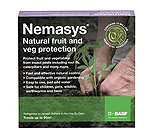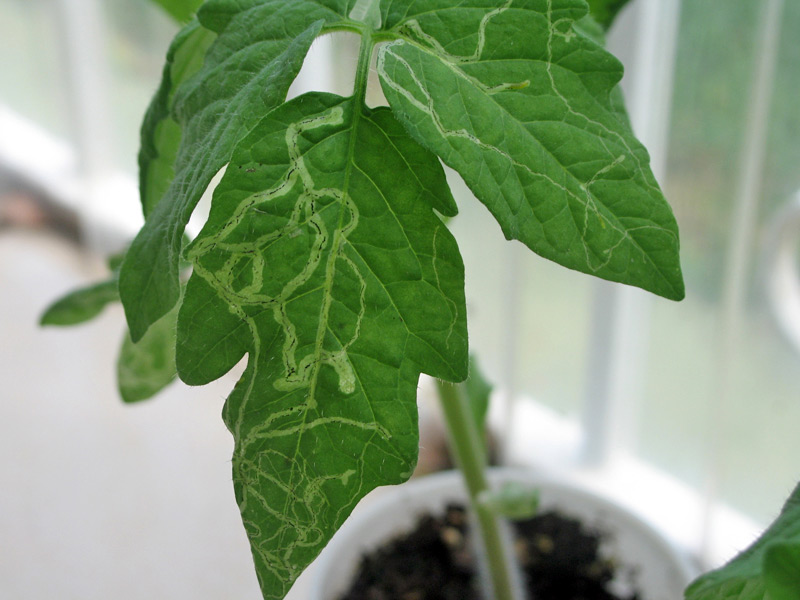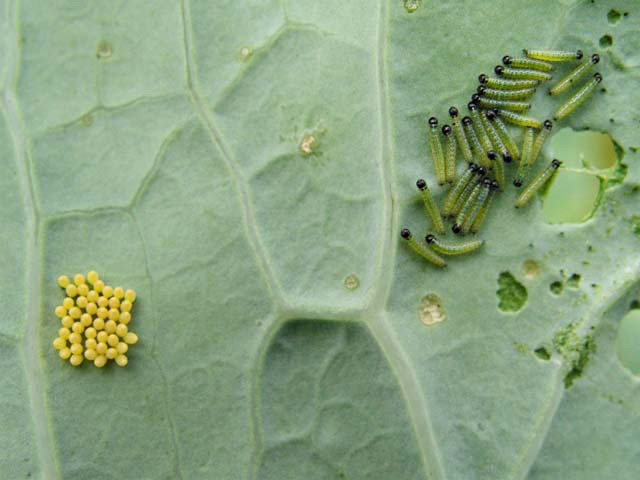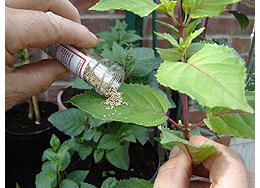Caterpillars - plant pest
Signs - Leaves stripped, or eaten from the outside edge inwards. Caterpillars themselves may not always be easily visible as they can be well camouflaged. "Frass" may be seen - tiny black balls of excrement (yes there's a special word for caterpillar poo - frass).
More cunning and smaller types "mine" leaves between the upper and lower surfaces.
Damage - Young leaves can be eaten away and more mature plants are left with unsightly holes, a severe infestation can completely strip the plant of leaves.
Treatments
 Nemasys
fruit and veg protector,
organic biological protection against a number of pests
such as carrot root fly, cabbage root fly, onion fly,
caterpillars and many more.
Nemasys
fruit and veg protector,
organic biological protection against a number of pests
such as carrot root fly, cabbage root fly, onion fly,
caterpillars and many more. 
Leaf miner damage on a tomato plant the tiny caterpillars burrow within the leaf between the top and bottom surfaces leaving a pale trail where the internal cells have been eaten.

Newly hatched caterpillars and
eggs of the large cabbge white butterfly under a leaf.
Picture courtesy Andy Potter
used CC Attribution, Share and sgare alike 2.0 generic
license.
 For
really heavy infestations consider using the organic biological
control based on a naturally occurring bacterium called
Bacillus thuringiensis, which
stops the caterpillar feeding and only infects caterpillars.
For
really heavy infestations consider using the organic biological
control based on a naturally occurring bacterium called
Bacillus thuringiensis, which
stops the caterpillar feeding and only infects caterpillars.
Gather 450g (1 lb) leaves and young stems of elder prefer-ably in spring when the sap is rising. Place in the saucepan and add 3.3 litres (6pt) water. Boil for half an hour, topping up as necessary. Strain through old tights and use the liquid cold and undiluted. It will keep for three months if bottled tightly while still hot.
Caterpillars are the larval stage of butterflies and moths, they hatch from eggs laid on the carefully chosen food plant by the adult females. They tend to be very specific in which plant they choose to eat and generally won't leave that plant to go elsewhere, the good news is that it means they won't spread to others, the bad news is as that is their only food source, they can often strip the food plant totally bare.
There are many different types of butterfly and moths of all sizes, far more than the usual few that people are generally acquainted with and most species are very small with very small caterpillars. If a plant is starting to appear to be a bit poorly for no immediately apparent reason, then look very carefully, especially under the leaves, you may well find the very small caterpillars of a small moth. These small and difficult to identify (even to experts) moths are known as the Microlepidoptera, relatively little is known about them specifically, but they are legion and very diverse in their food requirements.

Insect
hotel / house
A sheltered insect house to help a range of beneficial
insects to over-winter in your garden. If they are over-wintering there,
they are in an ideal position come the spring and summer to wake up and
help to combat any pests you may have. Amongst others, good for ladybirds,
lacewings and solitary wasps which will help keep your unwanted garden visitors
down. Place in a sheltered place outdoors.

Biological
Pest Control - Organic living pest control for a variety of
problems, red spider mite, whitefly, fungus gnats (sciarid fly), thrips, mealy bug,
vine weevils and more.
These are parasites or predators that will specifically infect the pest they are brought in to control without harming any other living things and without the use of chemicals. A small population of pests needs to be maintained so that the control agent doesn't die out.

Chemical insecticides - If your plants get a heavy infestation, then I think it's acceptable to use a chemical insecticide as a "smart missile" just on that particular plant. I resort to this when the aphids build up under cover on my favourite plum tree, or other plant/s. Don't overdo it and spray too often and don't spray the whole garden "just-in-case", buy a small 1L or thereabouts sprayer so you don't get carried away.
Not pest specific.

Caterpillars feeding on a birch leaf.

Caterpillars of the small (green) and large (yellow/black) cabbage white (it's a small large caterpillar and large small caterpillar)
Reasons to like caterpillars
- Refer to any small child of your acquaintance for a comprehensive answer.
- They turn into butterflies and moths "flying flowers".
- They provide loads and loads of food for small birds and plenty of larger animals further up the food chain too.
- They have provided the inspiration for many cartoon and children's story book characters such as "The Very Hungry Caterpillar" and that great masterpiece "inchworm, inchworm, measuring the marigolds...". Those fairground rounds for toddlers too - the ones that look like a big caterpillar curling up.
Copyright 2000 - present. All Rights Reserved | Privacy Policy Statement
